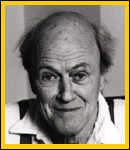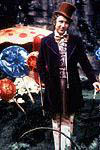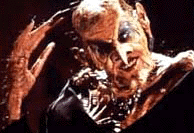Roald Dahl

 Roald Dahl
Roald Dahl

 Roald Dahl is one of the most successful and well-known of all children�s writers. Charlie & The Chocolate Factory is 30 years old this year. It was the second book that Roald Dahl wrote and it tells how five lucky characters win the chance to spend a day at Willy Wonka�s Chocolate Factory and what happens to them.
Roald Dahl is one of the most successful and well-known of all children�s writers. Charlie & The Chocolate Factory is 30 years old this year. It was the second book that Roald Dahl wrote and it tells how five lucky characters win the chance to spend a day at Willy Wonka�s Chocolate Factory and what happens to them.
 Charlie & The Chocolate Factory was first published in America in 1964 but it was turned down by countless British publishers before going on sale in Britain on 23rd November 1967. It caused controversy on a number of fronts - and the publisher, Rayner Unwin, received many letters of protest from libraries who refused to keep it on their shelves. Adults were shocked at the savagery of Dahl�s humour, whereas children loved it. It was also considered politically incorrect as Willy Wonka�s helpers, the Oompah Loompahs, were described as �little black pygmies from deepest Africa� until Dahl changed this, in 1973, to �tiny people with rosy-white skin and long blond hair.
Charlie & The Chocolate Factory was first published in America in 1964 but it was turned down by countless British publishers before going on sale in Britain on 23rd November 1967. It caused controversy on a number of fronts - and the publisher, Rayner Unwin, received many letters of protest from libraries who refused to keep it on their shelves. Adults were shocked at the savagery of Dahl�s humour, whereas children loved it. It was also considered politically incorrect as Willy Wonka�s helpers, the Oompah Loompahs, were described as �little black pygmies from deepest Africa� until Dahl changed this, in 1973, to �tiny people with rosy-white skin and long blond hair.
|
Roald Dahl was born in 1916 in Wales to Norwegian parents. He was an RAF fighter pilot during World War Two and began writing after being injured. A string of best-sellers followed - many of which have been made into films - including Charlie & The Great Glass Elevator, James and The Giant Peach, Danny Champion of the World, Matilda, Fantastic Mr Fox, The BFG, The Twits and The Witches. He is the only author to have 4 titles in the Waterstone�s top 100 books of the century. He has sold over 25 million books. Dahl died in 1990 at the age of 74.
|
How could anyone create such fantastic and imaginative stories? Roald Dahl truly had an overflowing imagination.
Roald Dahl's life was almost as fantastic as his books - here are just some amazing facts about Roald Dahl...
When he was at school Roald Dahl received terrible reports for his writing - with one teacher actually writing in his report, 'I have never met a boy who so persistently writes the exact opposite of what he means. He seems incapable of marshalling his thoughts on paper!'
After finishing school Roald Dahl, in search of adventure, travelled to East Africa to work for a company called Shell. In Africa he learnt to speak Swahili, drove from diamond mines to gold mines, and survived a bout of malaria where his temperature reached 105.5 degrees (that's very high!).
With the outbreak of the Second World War Roald Dahl joined the RAF. But being nearly two metres tall he found himself squashed into his fighter plane, knees around his ears and head jutting forward. Tragically of the 20 men in his squadron, Roald Dahl was one of only three to survive. Roald wrote about these experiences in his books Boy and Going Solo.
Later in the war Roald Dahl was sent to America. It was there that he met famous author C.S. Forester (author of the Captain Hornblower series) who asked the young pilot to write down his war experiences for a story he was writing. Forester was amazed by the result, telling Roald 'I'm bowled over. Your piece is marvellous. It is the work of a gifted writer. I didn't touch a word of it.' (an opinion which would have been news to Roald's early teachers!). Forester sent Roald Dahl's work straight to the Saturday Evening Post. Roald was now a published writer and set on the path that would lead him to great success.
Roald Dahl's growing success as an author led him to meet many famous people including Walt Disney, Franklin Roosevelt, and the movie star Patricia Neal. Patricia and Roald were married only one year after they met!
The couple bought a house in Great Missenden called Gipsy House. It was here that Roald Dahl began to tell his five children made-up bedtime stories and from those that he began to consider writing stories for children.
An old wooden shed in the back garden, with a wingbacked armchair, a sleeping bag to keep out the cold, an old suitcase to prop his feet on and always, always six yellow pencils at his hand, was where Roald created the worlds of The BFG, The Witches, James and the Giant Peach, Charlie and the Chocolate Factory and many, many more.

Roald Dahl didn't believe that stories just appeared, but that you had to work hard to think of them! 'You start with a germ of an idea,' he once said, '...a tiny germ... a chocolate factory? ... a peach, a peach that goes on growing...'
Roald Dahl would write all of these ideas in his beloved red exercise book. But if his exercise book wasn't handy he would scribble a note on anything to remind himself - even if he had to write in crayon or lipstick!

These are just some of the hints Roald Dahl wrote down for anyone who would like to become a successful author.


  Return to the Fridge door Return to the Fridge door |